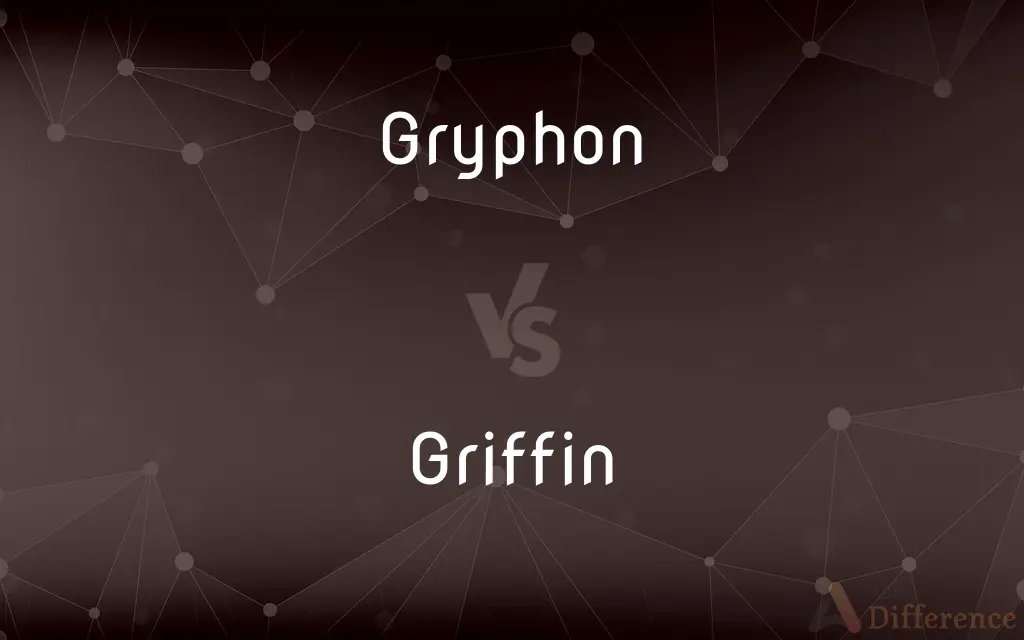Gryphon vs. Griffin — What's the Difference?
Edited by Tayyaba Rehman — By Maham Liaqat — Updated on March 7, 2024
Gryphon, often symbolizing divine power and a guardian of treasure, combines an eagle's head and wings with a lion's body, while Griffin is an alternative spelling of the same mythical creature, used interchangeably in different cultural context.

Difference Between Gryphon and Griffin
Table of Contents
ADVERTISEMENT
Key Differences
Gryphons are mythical creatures with the body, tail, and back legs of a lion, the king of beasts, and the head and wings of an eagle, the king of birds. This combination signifies strength, courage, and protection. Whereas, the term Griffin refers to the same creature, highlighting no physical difference but rather a variation in spelling and usage across different regions and periods in history.
The gryphon has been a symbol of divine power and a protector of the divine. It often guards treasures and priceless possessions. On the other hand, Griffin, under its different name, carries the same symbolic meanings across various cultures, including ancient Egyptian, Persian, and Greek, underscoring its universal representation of might and majesty.
The portrayal of gryphons varies from guardians of sacred places to wise and noble creatures. Meanwhile, Griffins are similarly depicted in various mythologies and stories, serving as noble steeds or fearsome adversaries, showcasing their versatility in narrative roles.
Gryphons are depicted with great detail in medieval tapestries and architecture, embodying strength and vigilance. Conversely, Griffin imagery can be found in similar contexts, often on crests and heraldry, symbolizing valor and watchfulness, with the spelling variation doing little to differentiate their representation.
Despite the different spellings, both gryphon and Griffin evoke a sense of awe and reverence in cultural and mythological studies. The names are used interchangeably, with preference usually given to regional spelling conventions, indicating a shared heritage and symbolism.
ADVERTISEMENT
Comparison Chart
Spelling Variation
"Gryphon" is an older spelling
"Griffin" is more commonly used in modern contexts
Symbolism
Represents strength, courage, and protection
Same symbolism as Gryphon
Cultural Significance
Featured in ancient mythologies as a guardian
Similarly revered in various cultures
Usage in Literature
Often depicted as guardians and noble creatures
Depicted in similar roles, with spelling variations
Artistic Representation
Common in medieval tapestries and architecture
Also prevalent in heraldry and crests
Compare with Definitions
Gryphon
A mythical creature with an eagle's head and wings and a lion's body.
The ancient temple was guarded by a statue of a gryphon.
Griffin
Appears in literature as noble beasts.
In the epic, heroes ride griffins into battle against dragons.
Gryphon
Represents a blend of majesty and strength.
Knights often used the gryphon as a symbol of their courage and power.
Griffin
Another spelling for a mythical creature combining an eagle and a lion.
The griffin symbolizes both air and earth's dominion.
Gryphon
Featured in various cultures' mythologies.
The gryphon appears in both Greek and Persian myths as a formidable creature.
Griffin
A guardian symbol in ancient cultures.
Griffin depictions were common in ancient tombs as protectors of the dead.
Gryphon
A motif in art and architecture.
The cathedral's facade featured a gryphon, symbolizing protection.
Griffin
Embodies the virtues of strength and vigilance.
The griffin atop the castle gate watches over the kingdom.
Gryphon
Symbol of divine power and protection.
In medieval lore, the gryphon was often seen as a guardian of treasure.
Griffin
Seen on family crests and heraldry.
The noble family's crest bore a griffin, signifying valor.
Gryphon
Variant of griffin.
Griffin
The griffin, griffon, or gryphon (Ancient Greek: γρύψ, grū́ps; Classical Latin: grȳps or grȳpus; Late and Medieval Latin: gryphes, grypho etc.; Old French: griffon) is a legendary creature with the body, tail, and back legs of a lion; the head and wings of an eagle; and sometimes an eagle's talons as its front feet. Because the lion was traditionally considered the king of the beasts, and the eagle the king of the birds, by the Middle Ages, the griffin was thought to be an especially powerful and majestic creature.
Gryphon
Alternative form of griffin
Griffin
A fabulous beast with the head and wings of an eagle and the body of a lion.
Gryphon
The griffin vulture.
Griffin
A mythical beast having the body of a lion and the wings and head of an eagle.
Gryphon
Winged monster with an eagle-like head and body of a lion
Griffin
A large vulture (Gyps fulvus) found in the mountainous parts of Southern Europe, North Africa, and Asia Minor, supposed to be the "eagle" of the Bible.
Griffin
An English variety of apple.
Griffin
A person who has just arrived from Europe.
Griffin
A cadet newly arrived in British India: half English, half Indian.
Griffin
A watchful guardian, especially a duenna in charge of a young woman.
Griffin
An Anglo-Indian name for a person just arrived from Europe.
Griffin
A fabulous monster, half lion and half eagle. It is often represented in Grecian and Roman works of art.
Griffin
A representation of this creature as an heraldic charge.
Griffin
A species of large vulture (Gyps fulvus) found in the mountainous parts of Southern Europe, North Africa, and Asia Minor; - called also gripe, and grype. It is supposed to be the "eagle" of the Bible. The bearded griffin is the lammergeir.
Griffin
An English early apple.
Griffin
Winged monster with an eagle-like head and body of a lion
Common Curiosities
What do griffins symbolize?
Griffins symbolize divine power, protection, and the dual kingship of the eagle (sky) and lion (land).
What is a gryphon?
A mythical creature with an eagle's head and wings and a lion's body, symbolizing strength and protection.
Are griffins depicted differently in different cultures?
While the basic depiction of griffins is consistent, artistic interpretations vary across cultures.
Where does the gryphon originate from?
Gryphons are found in ancient mythologies, including Egyptian, Greek, and Persian cultures.
How does a griffin differ from a gryphon?
Griffin is simply an alternative spelling for the same creature, with no difference in meaning or depiction.
Do griffins appear in heraldry?
Yes, griffins are common in heraldry, symbolizing strength, courage, and vigilance.
Why are gryphons used in fantasy settings?
Gryphons add a sense of wonder and danger, embodying the fantasy genre's exploration of mythical and magical elements.
Can gryphons be found in modern literature?
Yes, gryphons appear in various forms in modern fantasy literature and films.
What is the historical importance of griffins?
Historically, griffins were used as symbols to ward off evil and protect valuable items.
What role do gryphons play in mythology?
Gryphons are often seen as protectors of treasures and sacred sites.
What is the significance of a gryphon in art?
In art, gryphons represent a combination of majesty, strength, and protection.
Are there any famous stories featuring griffins?
Many myths and legends feature griffins, including those from Greek mythology and medieval European tales.
How are gryphons portrayed in films and media?
Gryphons are typically portrayed as majestic, powerful creatures, often allied with heroes or guarding treasures.
How are griffins used in video games?
In video games, griffins often serve as mounts, enemies, or allies, showcasing their versatility and power.
What do gryphons represent in dreams?
In dreams, gryphons may symbolize the need for protection or the merging of different aspects of the dreamer's personality.
Share Your Discovery

Previous Comparison
Method vs. Procedure
Next Comparison
Complete vs. FullAuthor Spotlight
Written by
Maham LiaqatEdited by
Tayyaba RehmanTayyaba Rehman is a distinguished writer, currently serving as a primary contributor to askdifference.com. As a researcher in semantics and etymology, Tayyaba's passion for the complexity of languages and their distinctions has found a perfect home on the platform. Tayyaba delves into the intricacies of language, distinguishing between commonly confused words and phrases, thereby providing clarity for readers worldwide.
















































